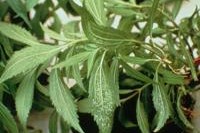Mist flower
Project overview
Biocontrol of mist flower (Ageratina riparia) was hugely successful in New Zealand. Mist flower, a garden escapee originally from Central America was, by the 1990s, rapidly spreading into native ecosystems in northern New Zealand, despite chemical and mechanical control.
Two biocontrol agents used successfully in Hawai’i were chosen for New Zealand: mist flower fungus (Entyloma ageratinae), released 1998; and mist flower gall fly (Procecidochares alani), released 2001.
Mist flower fungus spread rapidly in New Zealand causing massive impact on mist flower. Mist flower gall fly spread less rapidly, but both agents can attack simultaneously, and probably contribute to sustained mist flower suppression. By 2008, the percentage cover of mist flower in heavily invaded forest-plots had fallen to below 1%. The percentage of stem nodes regrowing after attack fell from 26% in 1999 to 2% in 2008, indicating reduced post-biocontrol plant vigour.
Mist flower is no longer an ecological threat in New Zealand, and other control is unnecessary. Native plant abundance in forest-plots increased, indicating improved forest health. Some secondary weed invasions occurred, but only where other weeds were already common. Two rare endemic plants, Hebe bishopiana and H. acutiflora, are less threatened because of successful mist flower biocontrol.
- pdf Still working after all these years - Issue 47, p.7 pdf File, 723 KB
- pdf Judgement day - Issue 39, p.6 pdf File, 741 KB




